This article has multiple issues. Please help improve it or discuss these issues on the talk page. (Learn how and when to remove these messages)
|
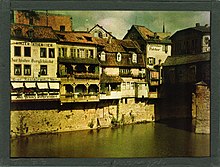
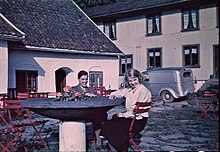
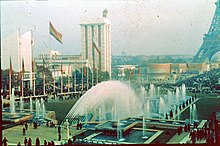
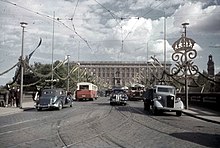
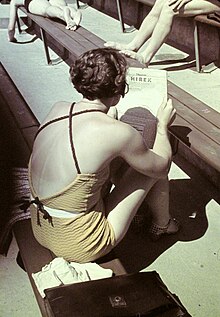


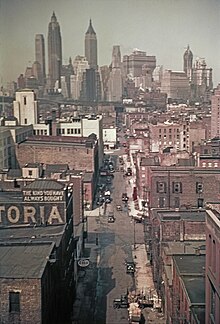
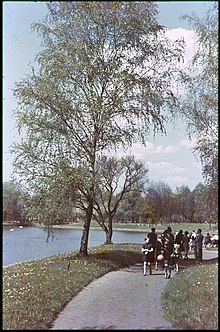

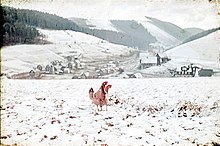

Agfacolor was the name of a series of color film products made by Agfa of Germany. The first Agfacolor, introduced in 1932, was a film-based version of their Agfa-Farbenplatte (Agfa color plate), a "screen plate" product similar to the French Autochrome. In late 1936, Agfa introduced Agfacolor Neu (New Agfacolor), a pioneering color film of the general type still in use today. The new Agfacolor was originally a reversal film used for making "slides", home movies and short documentaries. By 1939, it had also been adapted into a negative film and a print film for use by the German motion picture industry. After World War II, the Agfacolor brand was applied to several varieties of color negative film for still photography, in which the negatives were used to make color prints on paper. The reversal film was then marketed as Agfachrome. These films use Color Developing Agent 1 in their color developer.
Agfacolor Neu, called simply Agfacolor after its predecessor had been retired, was the German response to Technicolor and Kodachrome. Like Kodachrome, introduced by Eastman Kodak in 1935, the new Agfacolor film was an "integral tripack" with three differently color-sensitized emulsion layers. Unlike Kodachrome, the corresponding color-forming dye couplers were made integral with each layer during manufacture, greatly simplifying the processing of the film: with Kodachrome, the dye couplers had to be introduced one at a time during a very complicated development procedure that required special equipment and could only be done at a Kodak processing plant.
History
Development
Agfa was formed in 1867, and part of IG Farben from 1925 to 1945. Its Wolfen plant, which was the sole producer of Agfacolor film until the end of World War II, was constructed in 1909.
Realizing they were at least one year behind their American competitors, German technicians decided to steer away from Kodak's approach to capturing color images on film and invested in their own technology. Their work bore fruits in the summer of 1936, when chemical engineers of the Agfa company in Germany tested their new material Agfacolor at the swimming competition of the 1936 Summer Olympics in Berlin. Although the German technology promised the use of one and the same material for different purposes, ranging from photographic negative film for prints to photographic slides and motion picture films, it took another three years—until July 1939—for any German motion picture film studio to experiment with the film.
Early use in German motion picture films
The Third Reich's Minister of Propaganda Joseph Goebbels admired Hollywood movies and examined them carefully in regular private screenings (sometimes with Adolf Hitler and his staff). Technicolor films such as The Garden of Allah (1936), Gone with the Wind (1939) and Disney's Snow White and the Seven Dwarfs (1937) made him realize that Hollywood feature films presented a threat to Germany's internal market, and that Hollywood's dominance of color film technology should be matched, at least if Germany was serious about engaging in a cultural war with the US and Britain.
Women Are Better Diplomats
It was not until the beginning of principal photography for Women Are Better Diplomats (German: Frauen sind doch bessere Diplomaten) a 1939 musical starring the singer/dancer Marika Rökk and actor Willy Fritsch that Agfacolor was used for a major motion picture. The use of Agfacolor was reinforced by the top of the Nazi film industry, Reichsminister Joseph Goebbels, and the executives at UFA eventually gave in to his pressure. Agfacolor was then used throughout the entire film shoot of Women Are Better Diplomats.
Throughout the shoot, the film yielded mixed results as it was still very sensitive to different color temperatures caused by solar altitude at different times of day. Thus, outdoor shots were difficult to handle: A lawn in front of a castle appeared completely yellow, later brown, then bluish. The technology was not fully developed, and Agfa labs were virtually using the shooting of the film as testing grounds for their new stock, continually changing the formula throughout the shoot based upon unsatisfactory results, so that entire scenes had to be repeated once a new formula was being tested.
Meanwhile the production costs had risen from 1.5 to 2.5 million ℛ︁ℳ︁. More than two years after its start date, Women Are Better Diplomats opened in October 1941. Despite its rather weak color quality, the film proved to be a major hit, earning more than 8 million ℛ︁ℳ︁ by the end of the war.
The Golden City
After the process's growing pains had been overcome throughout the production of Women Are Better Diplomats, the following Agfacolor movies were shot and printed much quicker and with better results. The technology was improved at a rapid pace. Veit Harlan was allowed to shoot his next picture in Agfacolor. Between the summers of 1941 and 1942, Veit Harlan finished Die goldene Stadt (Eng: The Golden City), a dreamy propaganda fairytale starring his wife Kristina Söderbaum as a young, innocent country girl who comes to the golden city of Prague and is seduced by an unscrupulous gigolo.
The Golden City premièred at the Venice Film Festival in September 1942 and was awarded for its outstanding technical quality, and actress Kristina Söderbaum won an acting award. Shot by cameraman Werner Krien, who had done black-and-white pictures before, and assisted by special effects specialist Konstantin Irmen-Tschet (once in charge of the SFX camera in Fritz Lang's Metropolis), the film displays an impressive symphony of colors.
Later Agfacolor films during the Third Reich
Made for UFA's 25th Anniversary, Münchhausen (1943) was the third German feature film – out of over a dozen – to be produced using Agfacolor film between 1939 and 1945. Other Agfacolor productions include The Woman of My Dreams (1944), a musical starring Marika Rökk and Kolberg (1945), a dramatization of German resistance throughout the Napoleonic Wars and the regime's last major propaganda feature film. A significant number of Agfacolor movies shot between 1939 and 1945 survived the war, but most of them exist only in fragments today.
Legacy of World War II
Towards the end of World War II, large quantities of raw Agfacolor stock were seized by the Soviet Union and served as the basis for the Sovcolor process, which was widely used in the USSR and other Eastern bloc nations; such films produced in Poland were also described as Polcolor, the first being Adventure at Marienstadt (1954). One of the best-known Sovcolor films is War and Peace (1965–67) and many of Andrei Tarkovsky's films used it as well. Sovcolor was known for the variable quality of its colors, which led to continuity errors as colors changed between scenes; more prestigious productions used imported Eastman Kodak stock instead.
Agfa was divided into Agfa-Werke, a subsidiary of Farbenfabriken, in West Germany and Agfa Wolfen in East Germany after World War II and the division of Germany. Agfa-Werke opened a plant in Leverkusen. Agfa Wolfen sold the Agfa brand rights to Agfa-Werke in 1964, and changed its name to ORWO. Agfa-Werke merged with Gevaert that same year to form Agfa-Gevaert.
Agfacolor consumer products were also marketed in North America under the names Ansco Color and Anscochrome (from Agfa's then-US subsidiary, Agfa-Ansco). Prior to World War II, the film had been imported from Germany. After the War began, the American subsidiary was seized by the US Government. At the request of the War Department, Ansco then developed a similar color film, which it produced in its own factory in Binghamton, New York. Anscochrome was widely distributed, but met with limited commercial success in competition with Kodak product.
Ansco Color was also used in Hollywood films, including some produced by Metro-Goldwyn-Mayer. Films shot in Ansco Color included The Man on the Eiffel Tower (1949), Bwana Devil (1953), Kiss Me, Kate (1953), Seven Brides for Seven Brothers (1954), Brigadoon (1954), and Lust for Life (1956), the final film shot on this film stock. Anscochrome films for still photography were manufactured until 1977. Agfacolor was used in one of the first color French comedy and topless films with Louis de Funès called Women of Paris (fr. Ah! Les belles bacchantes) dated 1954.
Agfacolor during the Second World War
Famous professional early works made in Agfacolor were war photo reports made during Invasion of Poland (1939) by Hugo Jaeger; Paris during German occupation (1940-1944) by André Zucca; Warsaw Ghetto Uprising (1943) by Zbigniew Borowczyk (3 photos), Karol Grabski (1 photo) and Rosemarie Lincke (1 photo); Warsaw Uprising (1944) by Ewa Faryaszewska and Gerhard Wiechmann; Prague uprising (1945) by Oldřich Cerha and during Hungarian Revolution of 1956 by Jeno Kiss. Works were made by occupants and also by resistance members. All photographs survived in excellent condition.
In 1978, Agfa ceased production of color film based upon the original Agfacolor process, switching to Kodak's C-41 process.
References
- The glass-based Agfa color plate was announced in 1916, but because of World War I and its aftermath, the product was not properly introduced until the early 1920s.
- Based upon the patent no. 253335 of Dr. Rudolf Fischer, 1911, Berlin
- Fenech, Ann. Lifetime of Colour Photographs in Mixed Archival Collections (PDF) (Doctoral thesis). University College London. S2CID 107323281.
- Street & Yumibe 2024, p. 30.
- Everett, Wendy Ellen; Everett, Wendy (February 21, 2007). Questions of Colour in Cinema: From Paintbrush to Pixel. Peter Lang. ISBN 978-3-03911-353-8 – via Google Books.
- "Sovcolor negative film type B".
- Limbacher, James L. (February 21, 1978). Four Aspects of the Film. Arno Press. ISBN 978-0-405-11138-9 – via Google Books.
- Roy, André (February 21, 2007). Dictionnaire général du cinéma: du cinématographe à Internet: art, technique, industrie. Les Editions Fides. ISBN 978-2-7621-2787-4 – via Google Books.
- Reid, John Howard (January 1, 2007). Science-fiction & Fantasy Cinema: Classic Films of Horror, Sci-fi & the Supernatural. Lulu.com. ISBN 978-1-4303-0113-4 – via Google Books.
- Misek, Richard (April 26, 2010). Chromatic Cinema: A History of Screen Color. John Wiley & Sons. ISBN 978-1-4443-3239-1 – via Google Books.
- Jesse, Arthur. "Metal Picture Prints". Retrieved 8 December 2023.
- Street & Yumibe 2024, pp. 30–31.
- Anscochrome and Ansco color transparencies slides. Archived 2013-02-13 at the Wayback Machine June 11, 2010.
- About Ansco. February 07, 2008.
- Camp, William L. Ansco Chronology, From a Binghamton, N. Y. point of view. July 14, 2011.
- "Ah ! Les belles bacchantes – les Branquignols".
- Women of Paris is a translation of title for the Spanish market.
- "Invasion of Poland, 1939: Color Photos From WWII's First Front". November 12, 2014. Archived from the original on 2014-11-12.
- "Warszawa. Płonące getto | Wirtualny Sztetl". Archived from the original on 2019-10-27. Retrieved 2019-10-27.
- Mwadmin (7 February 2017). "Fotografie ruin. Ruiny fotografii 1944–2014". Muzeum Warszawy.
- "Vhu Praha". 18 May 2015.
- "Hungary: 1956 Uprising in color - Images | EST&OST".
Works cited
- Street, Sarah; Yumibe, Joshua, eds. (2024). Global Film Color: The Monopack Revolution at Midcentury. Rutgers University Press. ISBN 9781978836839.
Further reading
- Coe Brian, Colour Photography: The First Hundred Years 1840–1940, Ash & Grant, 1978
- Gert & Nina Koshofer, Dr. Rolf Giesen, Friedrich-Wilhelm-Murnau-Stiftung, Wiesbaden, 2005
- www.pixpast.com a source for collectors of original 35mm and 16mm agfacolor film from 1936 to 1945.
External links
- Color photo report from car journey to Paris, Monaco and Rome made in 1938 using Agfacolor process by Polish racing driver Witold Rychter from Warsaw.
- Agfacolor on Timeline of Historical Film Colors with many written resources and many photographs of Agfacolor prints.